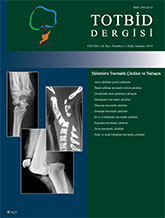
Shoulder joint has more risk than other joints in terms of dislocations because it has a larger movement range. Over 95% of anterior shoulder dislocations and 67% of posterior shoulder dislocations are caused by traumas. Over 90% of traumatic dislocations are anterior dislocations. Traumatic anterior shoulder dislocations occur due to forcing the arm in abduction and external rotation positions, whereas the rarely observed posterior shoulder dislocations occur due to forcing the arm in adduction, flexion, and internal rotation. In traumatic anterior shoulder dislocations, patients hold their arm in slight external rotation and abduction. Since humeral head shifts towards the anterior, the gap in the lateral of the shoulder can be palpated. In traumatic posterior shoulder dislocation, the arm is frequently in internal rotation, there is external rotation limitation and the coracoid process becomes distinctive in the anterior. Recurrent dislocation rates following traumatic anterior shoulder dislocations are between 14% and 100%. The factors affecting this rate are: the age of the patients at the time of dislocation, male gender, contact or overhead sports, hyperlaxity, incompliance with the rehabilitation program, existence of bone defect, concomitant rotator cuff tears, and axillary nerve damage. The main purpose of shoulder dislocation treatment is to provide a painless, fully functional, and stable joint. It would be appropriate to initially apply the conservative treatment in patients above 40 years of age with limited overhead activity. Arthroscopic labral repair is the first treatment option for shoulder instability surgery. Interventions such as bone block operations, coracoid transfer, and `remplissage` are preferred especially for anterior instability with the existence of large bone defects, whereas interventions such as filling the defect with bone graft or shifting the subscapularis to the defect are preferred for posterior instability.